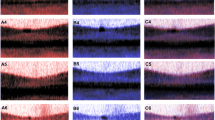Summary
We have investigated the role of changes in corneal radius of curvature in effecting accommodation in the bird's eye. It was found that in natural accommodation (measured by IR photoretinoscopy) changes of corneal radius of curvature (measured by IR photokeratometry) play an important role in both the chick and the pigeon. In the adult pigeon the cornea is indeed responsible for the largest part of natural accommodation (up to approx. 9 D). In this animal the corneal diameter (as seen from the optical axis of the eye) decreases in accommodation which can be taken to explain the change of corneal radius of curvature. In the chicken, corneal accommodation is combined with other mechanisms (total accommodative range 15–17 D, corneal accommodation about 8 D). The chicken's cornea is aspherical within the pupil area leading to large measurement variation in photokeratometry if the Purkinje images are not symmetrical to the pupillary axis.
Similar content being viewed by others
Abbreviations
- IR:
-
infrared
References
Beer T (1893) Studien über die Akkommodation des Vogelauges. Pflügers Arch 53:175–237
Gundlach RN, Chard RD, Skahen JR (1945) The mechanism of accommodation in the bird eye. J Comp Psychol 38:27–42
Hay SH, Kerr JH, Jayroe RR, White JC, Funke M (1983) Retinal reflex photometry as a screening device for amblyopic and preamblyopic states in children. South Med J 76:309–312
Hodos W, Besette BB, Macko KA, Weiss SRB (1985) Normative data for pigeon vision. Vision Res 25:1525–1527
Howland HC (1985) Optics of photoretinoscopy: results from ray tracing. Am J Optom Physiol Opt 62:614–620
Howland HC, Howland B (1974) Photorefraction: a technique for study refractive state at a distance. J Opt Soc Am 64:240–249
Howland HC, Sayles N (1985) Photokeratometric and photorefractive measurements of astigmatism in infants and young children. Vision Res 25:73–81
Howland HC, Braddick O, Atkinson J, Howland B (1983) Optics of photorefraction: orthogonal and isotropic methods. J Opt Soc Am 73:1701–1708
Kaakinen K (1979) A simple method for screening of children with strabismus, anisometropia or ametropia by simultaneous photography of the cornea and the fundus reflex. Acta Ophthalmol (Copenh) 57:161–171
Levy B, Sivak JG (1980) Mechanisms of accommodation in the bird eye. J Comp Physiol 137:267–272
Mandelman T, Sivak JG (1983) Longitudinal chromatic aberration in the vertebrate eye. Vision Res 23:1555–1559
Meyer DB (1977) The avian eye and its adaptations. In: Crescitelli F (ed) The visual system in vertebrates (Handbook of sensory physiology, vol VII/5). Springer, Berlin Heidelberg New York, pp 549–612
Molteno ACS, Hoare-Naire J, Parr JC, Simpson A, Hodgkinson IJ, O'Brien NE, Watts SD (1983) The otago photoscreener, a method for the mass screening of infants to detect squint and refractive errors. Trans Ophthalmol Soc NS 35:43–49
Reymond L (1985) Spatial acuity of the eagle,Aquila audax: a behavioral, optical and anatomical investigation. Vision Res 25:1477–1491
Rosenthal D (1981) A model of avian accommodation. M Sc Diss Polytechnic Inst New York
Schaeffel F, Howland HC, Farkas L (1986) Natural accommodation in the growing chicken. Vision Res 26:1977–1993
Sivak JG (1980) Accommodation in vertebrates: a contemporary survey. In: Zadunaisky JA, Davson H (eds) Current topics in eye research vol. 3. Academic Press, New York, pp 281–330
Sivak JG, Hildebrand T, Lebert C, Myshiak L, Ryall L (1986) Ocular accommodation in chickens: cornea vs. lenticular, effect of age. Vision Res 26:1865–1872
Slonaker JR (1918) A physiological study of the anatomy of the eye and its accessory parts of the English Sparrow (Passer domesticus). J Morphol 39:351–459
Steinbach MJ, Money KE (1973) Eye movement in the owl. Vision Res 13:889–891
Suburo AM, Marcantoni M (1983) The structural basis of ocular accommodation in the chick. Rev Can Biol Exp 42:131–137
Troilo D, Wallman J (1986) Changes in corneal curvature during accommodation in chicks. Vision Res (in press)
Walls GL (1942) The vertebrate eye and its radiative radiation. Cranbrook Institute of Science, Michigan
Young T (1801) On the mechanism of the eye. Philos Trans R Soc Lond 19:23–88
Author information
Authors and Affiliations
Rights and permissions
About this article
Cite this article
Schaeffel, F., Howland, H.C. Corneal accommodation in chick and pigeon. J. Comp. Physiol. 160, 375–384 (1987). https://doi.org/10.1007/BF00613027
Accepted:
Issue Date:
DOI: https://doi.org/10.1007/BF00613027




